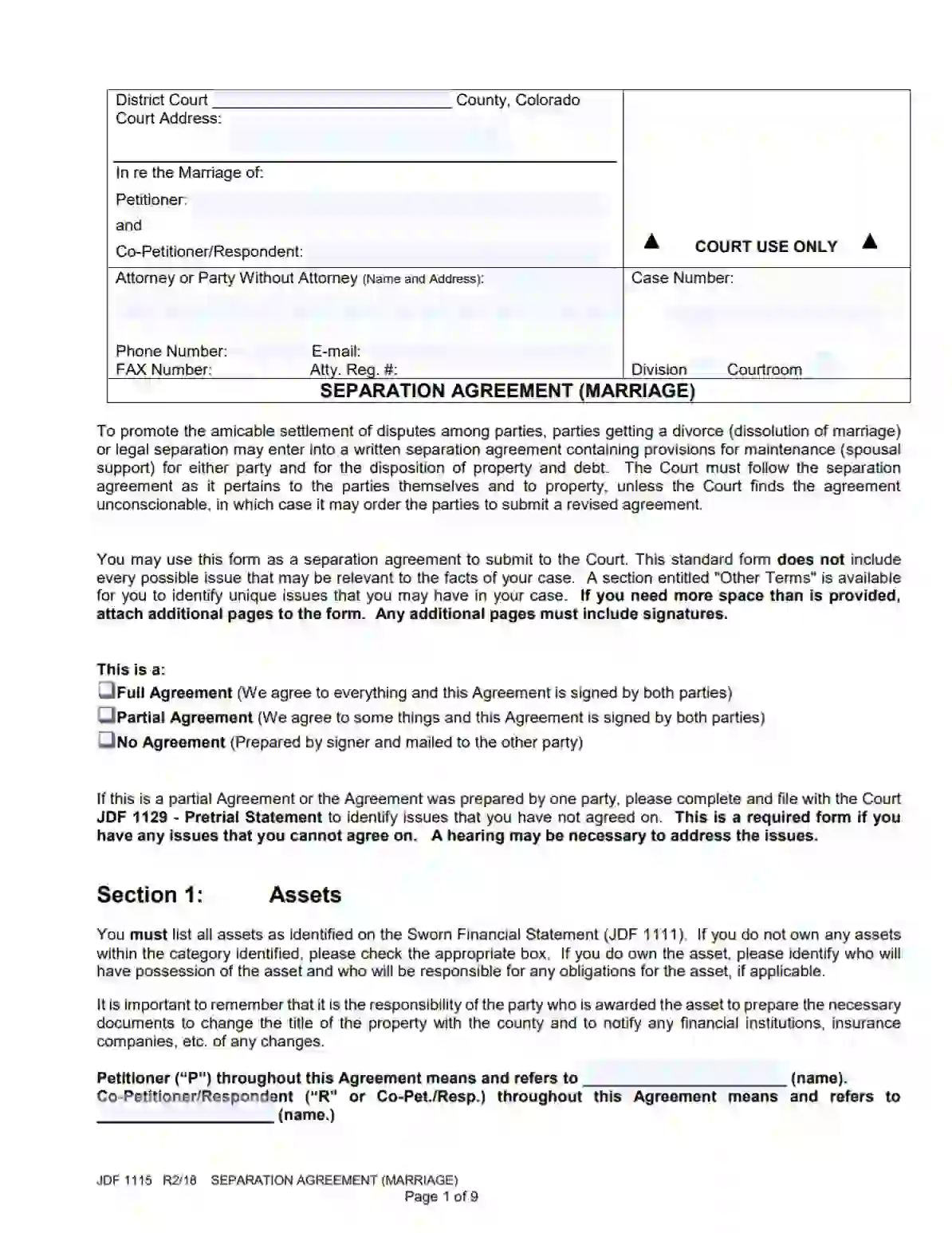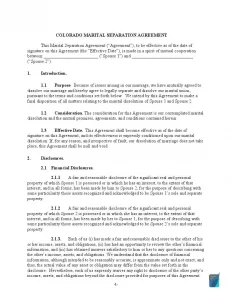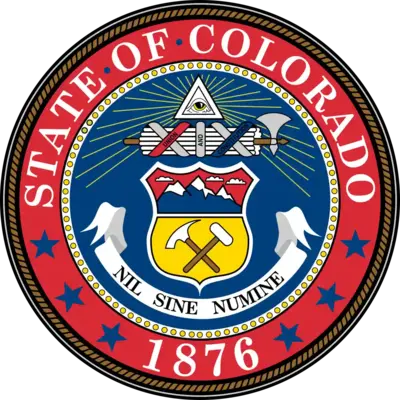Colorado Marital Settlement (Divorce) Agreement and Legal Separation
We want to get you acquainted with the Colorado Marital Settlement Agreement Form in this legal form review. As it appears from its name, the fillable marital settlement agreement template is used to settle all possible post-marital matters and issues between the former spouses once their marriage is over. Usually, the paper covers existing monetary disputes, property division, child custody, spousal support, healthcare, retirement, and other family-related issues.
Divorce seldom ends on a good note. Most commonly, this procedure leaves a significant footprint on all the involved parties’ lives, and it is not a positive one. Therefore, it becomes even more critical to know the local laws and regulations to help you avoid misunderstandings, arguments, misconceptions, or legal disputes. It is essential to keep in mind that the parties used to share a roof, a bed, and maybe even kids, so the marriage dissolution should be as smooth as possible.
This article contains the necessary information on the divorce operating procedure the state residents can invoke to launch their post-marital settlement process.

Build Your Document
Answer a few simple questions to make your document in minutes
Save and Print
Save progress and finish on any device, download and print anytime
Sign and Use
Your valid, lawyer-approved document is ready
Colorado Divorce and Separation Laws
You can find the legal norms and requirements regarding the state divorce procedure in the Colorado Revised Statutes (Title 14, Article 10). The Act under this Article is universal for the entire state. It contains provisions that guide state residents once they mutually agree to divorce (or request legal separation) in the state. Thus, the provisions under the Colorado Marriage Dissolution Act serve the following objectives:
- Promote amicable principles to the settlement of dissolution disputes;
- Mitigate and mediate the potential harm the spouses can cause both to their shared children and each other by the legal proceedings and trials;
- Adjust the state marriage dissolution law to a specific case and make it more effective when dealing with a particular couple’s matrimonial experience;
- Provide additional protection and safeguards to a parent (or minor) with a disability.
Another important detail is that you and your partner have to be Colorado residents for at least 91 days in a row to request a divorce from the local authorities. If you do not comply with this requirement, you may as well not even bother filing.
Grounds for Divorce
The Colorado authorities only recognize no-fault reasons for a marriage dissolution as lawful. So, the court will review and hear your case out if you file for an irretrievable breakdown of the marriage. By doing so, you admit that the legal relationship dissolution is the sole option to resolve your irreconcilable differences with your spouse. Other cases are considered void in the state, and the couple will probably be sent to mediation.
Property Division
Colorado is one of the states supporting the equity principle in marital property division matters. The name reflects the very essence of this principle. It means that all the property assets and other dwelling or tangible units will be distributed between the parties equally.
Child Custody and Visitation
The local authorities allow for including custodian matters in the marital settlement agreement. Upon the agreement enforcement, one parent is assigned a legal custodian, and the other becomes an attendant. Both of them are entitled to participate in their child’s life equally (or to the extent they view most appropriate).
Under the Parenting Time Enforcement Act enforced by the state Revised Statutes, the Colorado Marital Settlement Agreement can also include conditions on:
- Voluntary and mandatory court mediation
- Family counseling
- Participation in state parental education programs
- Parenting plans development
- Parenting time enforcement procedures and guidelines (monitored, supervised, or neutral, including drop-off and pickup locations)
- Alternative parenting time arrangements concerning parental responsibilities
Popular Local Marital Settlement Agreement Forms
A marital settlement agreement, also known as a property settlement agreement, is a legal instrument that can enable you to work out the divorce proceeding and prevent unnecessary headache. Here are the states the residents of which look for this template the most.
Child Support and Alimony
The legal term for child alimony and parental (or spousal) support accepted throughout the state is “maintenance,” and that is how we will refer to it in this review.
Usually, the court assigns parental responsibilities, including the amount of minors’ maintenance. The assigning procedure is quite simple except for the technicalities; they are the tricky part. So, once the spouses file for the irretrievable marriage dissolution, and they have a shared child, the court will most likely assign maintenance to the child of the marriage unless:
- Paternity is neither mentioned nor adjudicated
- One party requests a decree of legal separation instead of marriage dissolution
- The court order directly contains a paternity disclaim
Legal Separation
Legal separation is possible in the state, but it is a procedure that mainly concerns people who enter civil unions and reside together. Such a couple that has formed a civil union and then has decided to dissolve it may ask the court to issue a legal separation decree. However, the couple only needs to file for that decree if the parties have mutual property, minor children with shared custody, monetary issues, financial obligation, and other responsibilities they would like to affix legally. In all the rest cases, the couples can dissolve their civil unions without going to court.

Filing for Divorce in Colorado
Like any other legal process, the divorce settlement in Colorado involves several crucial steps or milestones. This article provides you with detailed recommendations on compiling and filling out a set of divorce documents for a Marital Settlement Agreement in Colorado. Please pay special attention to the filing order and local peculiarities. Use the recommendations below to organize the proceeding. Also, keep in mind that the divorce procedure with and without minor children involved differs significantly.
The Colorado separation settlement agreement is quite a large document, so brace yourself; you and your partner will have a long way to cover before getting divorced. The legal procedure might take from six to nine months.
1. Gather the Necessary Legal Forms and Fill them Out
The first and probably the most crucial step is to gather all the necessary legal forms and papers and fill them out correctly. One needs a full list of documents to compile a post-marital agreement on the state legislature’s official website. You can download the documents online and make yourself a checklist to make sure you have not forgotten anything. But if you doubt your legal skills, we suggest seeking legal assistance in completing your divorce forms.
2. File the Papers to the District Court
The District Court is responsible for reviewing all the incoming divorce cases. Once you have finished filling out the divorce papers, file them to the local District Court. Make sure you define the jurisdiction correctly. You will also have to pay a registration fee of $230 for the court to accept your application and launch the dissolution process. Once you fulfill all formalities, both you and your spouse will be invited to the Initial Status Conference hearing.
3. Await the Counter Response
Typically, as one party files for divorce, the other party has to answer, and there is a particular procedure for that. The responding party has to either accept the petition and move on with the process or file a counter-petition instead. If your former spouse does not have anything against the marital settlement agreement conditions you propose and is not willing to counter file, you should provide them with a notice and copies of all the paperwork. If the respondent counter files, they have to fill out the Response to the Marriage Dissolution (or Legal Separation) Petition. If the spouses decide to divorce mutually and file a joint petition, no service of paperwork is required.
4. Supply Required Supporting Documents
The parties have forty-two days to provide supporting documents to the court. Supporting documentation will help the judge determine your post-marital settlement’s essential terms and conditions, including custody, alimony, parenting plans, and other relevant matters.
You can include the following documents in your supporting file:
- Both parties’ Financial Disclosure of their income and the Certificate of Compliance
- Parenting plans and documents
- Post-marital Separation Agreement
- Spousal Support and Alimony Order
- Decree of Marriage Dissolution (or Legal Separation)
- Affidavit for Decree without Appearance (of the parties before the court)
5. Get a Hearing or Status Conference Appointment
Once the court reviews the case, analyses the paperwork, and decides that it is sufficient, the couple receives the Case Management Order with detailed information on the date, time, and court hearing location.
The schedule starts with one party issuing the Notice to Set Court Hearing (or a Status Conference). One copy goes to the court directly, and the other has to be served to the opposing party. If the court decides that the hearing is necessary, it forwards your request to the responsible clerk and sets forth an appointment.
6. Proceed to the Court Hearing
Both parties do not have to show up at the hearing. Usually, if all the disputed questions and matters have been agreed upon beforehand, and spouses have managed to handle the arguments mutually, they can receive their copy of the court’s Final Decree by mail. However, ensure you contact the responsible District Court clerk and determine if you should come to the hearing because unlawful non-attendance may lead to legal.
7. File for Changing Your Post-Marital Name (optional)
This final step is entirely optional. You can change your married name back to the initial by submitting the Final Court Decree and paying a small registration fee of $20. But keep in mind that you will also have to change all your existing documents, including the Social Security Number, taxpayer number, ID card, driver’s license, and so on, and that might take quite some time.

Take a look at some other Colorado forms completed by FormsPal users. Try our simple creator to customize these documents to your preferences.
Other Marital Settlement Agreement Forms by State